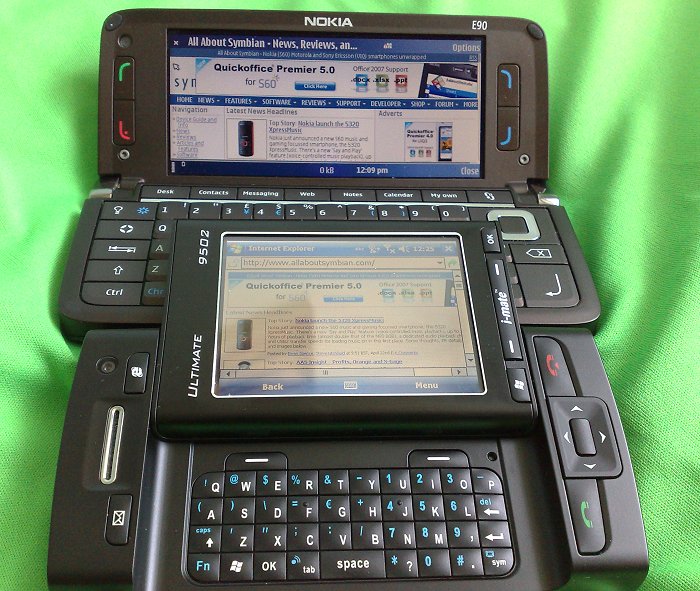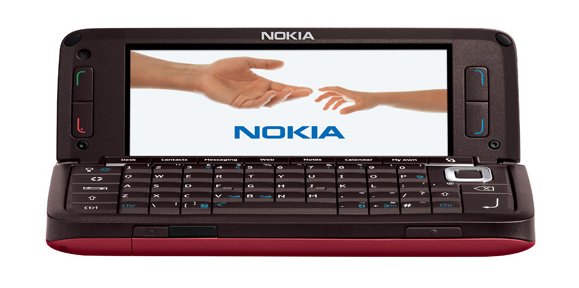Exclusive Smartphone Group Test. Day Two: The Nokia E90In the world of mobile phones, size matters. If this is the case for you then you won’t like the Nokia E90. If you can compromise you will get a top class mobile phone. The E90 offers it all. This is my first time really using a communicator device from Nokia on a day to day basis and I was left very impressed. The usability is straight forward, the product is well built and feels very solid, and the battery performs very well. In 10 days of usage I’ve had to charge the phone twice. Overall I would not hesitate to recommend the E90, it really is out on its own in terms of features and functionality. The Nokia E90 is an amazing product. With so many features you would expect some level of complication in use, so it is a testimony to the user interface of S60 that everything is laid out in a logical manner and just simply works. Dimensions 132 x 57 x 20mm Weight 210g Main Display Dual screen, both screens are 16M true colours, phone automatically switches screens depending on whether the phone is open or closed. Inner screen size – 800 x 352 pixels Outer screen size - 240 x 320 pixels Camera3.2 mega pixel with flash and autofocus. Video calling enabled Memory128MB free memory, extendible up to 2GB with microSD memory card Features 3G HSDPA WLAN Bluetooth IrDA GPRS Edge MP3 player plus FM Radio Java Quad band GSM Instant Messaging Media Player Quick Office Adobe Infrared Calendar Built in GPS receiver  To say that the E90 is "long awaited" would be an understatement. One of the weaknesses of the 9500 and the 9300 and 9300i devices derived from it was a lack of 3G support, and the E90 now adds that. But it's more that just a port of the old Communicator platform to 3G, the Nokia E90 also adds a GPS receiver and integrated navigation application, a 3.2 megapixel camera, FM radio and a significantly improved screen. As with the 9500, the Nokia E90 retains WiFi support and has a full QWERTY keyboard (although the keyboard has been improved in the E90). To say that the E90 is "long awaited" would be an understatement. One of the weaknesses of the 9500 and the 9300 and 9300i devices derived from it was a lack of 3G support, and the E90 now adds that. But it's more that just a port of the old Communicator platform to 3G, the Nokia E90 also adds a GPS receiver and integrated navigation application, a 3.2 megapixel camera, FM radio and a significantly improved screen. As with the 9500, the Nokia E90 retains WiFi support and has a full QWERTY keyboard (although the keyboard has been improved in the E90).The Communicator series of devices have always had the unfortunate nickname of "the brick", and the Nokia E90 continues in that tradition. At a hefty 210 grams, the E90 is actually 20 grams lighter than the 9500, but 38 grams heavier than the 9300i. Nokia have done a remarkable job with size though - when viewed from the front (see left), the E90 is about the height and thickness of the compact 9300/9300i while retaining the same width as the 9500 at 132 x 57 x 20mm. Inside the E90 is a display with an impressive 800x352 pixels resolution in 16 million colours, not unlike the panel on the Nokia N800, this is up from 640x200 pixels on the earlier models. The external display is now 240x320 pixels (up from 128x128), and pretty much all of the E90's functions can be controlled from the front cover, rather than the 9500/9300/9300i which allowed access to basic phone functions only. The 800 pixel wide display is ideal for no-compromise web access, although it doesn't have touchscreen support.  Of course, the E90 bears the "Communicator" name for a reason, and it comes with a wide range of communications options. Email support includes standard SMTP/POP3 protocols, various push email options, instant messaging and it even comes with a text-to-speech reader. Network support is quad-band GSM (850/900/1800/1900 MHz) plus 2100 MHz UMTS (3G), GPRS and EDGE. Significantly, the Nokia E90 does include HSDPA support allowing for download speeds of up to 3.6Mbit/sec. On top of this the E90 comes with 802.11g WiFi. It's hard to fault the E90 in terms of the networks it supports, but one omission is the ability to work with UMTS networks on anything other than the 2100 MHz band, which limits its 3G use in the US and some other countries. Of course, the E90 bears the "Communicator" name for a reason, and it comes with a wide range of communications options. Email support includes standard SMTP/POP3 protocols, various push email options, instant messaging and it even comes with a text-to-speech reader. Network support is quad-band GSM (850/900/1800/1900 MHz) plus 2100 MHz UMTS (3G), GPRS and EDGE. Significantly, the Nokia E90 does include HSDPA support allowing for download speeds of up to 3.6Mbit/sec. On top of this the E90 comes with 802.11g WiFi. It's hard to fault the E90 in terms of the networks it supports, but one omission is the ability to work with UMTS networks on anything other than the 2100 MHz band, which limits its 3G use in the US and some other countries.More controversially, the Nokia E90 includes a 3.2 megapixel camera with autofocus and flash. Many business do not like cameras in their business phones, and for some it was an issue with the 9500 (which had a VGA resolution camera) which was resolved with the camera-less 9300. There's also a secondary camera for video calling.  One very significant change from the 9500 is under the hood. This is a Symbian S60 (Series 60) smartphone, rather than the Series 80 operating system on the 9500 and 9300. Although this seems like a step backwards (because Series 80 was written specifically for this type of device), S60 support gives E90 users access to a much wider range of applications. Nokia 9500 users should adjust quickly to the new interface. One very significant change from the 9500 is under the hood. This is a Symbian S60 (Series 60) smartphone, rather than the Series 80 operating system on the 9500 and 9300. Although this seems like a step backwards (because Series 80 was written specifically for this type of device), S60 support gives E90 users access to a much wider range of applications. Nokia 9500 users should adjust quickly to the new interface.As with previous models, the Nokia E90's software capabilities are impressive. It includes a document editor called Quickoffice, can view Microsoft Office documents, work with Zip files and PDFs and there's a comprehensive set of  Personal Information Management tools. Because this is an S60 device, more applications can be added.. although most will need to be adapted for the E90's display. Personal Information Management tools. Because this is an S60 device, more applications can be added.. although most will need to be adapted for the E90's display.Another important feature is the Nokia E90 Communicator's inbuilt GPS function. This allows for more than just basic location-based services, as Nokia are going to make it's "Nokia Maps" application available. Although this seems to be a free SatNav (satellite navigation) package, it's worth remembering that a lot of the value added features require a network connection which might incur data costs. On top of all the other features, the Nokia E90 Communicator is also a multimedia phone, with support for MP3 and AAC audio plus video clips. There's even an FM radio. Data and media clips can be stored on microSD cards with a maximum capacity of 2GB. Did we mention that it makes phone calls? Because the thing with the Nokia E90 Communicator is that it is essentially a tiny handheld computer rather than a phone.. although, of course it does work exactly as you'd expect. Talktime on GSM is quoted at up 5 hours with a maximum of 14 days standby. Of course, Bluetooth, WiFi and 3G use will shorten that time. Nokia say that the E90 will initially be available during Q2 2007 with full production coming onstream in Q3, although from past experience we wouldn't be surprised if it was late. All of this technology comes at a price, at the E90 will cost around €800 / £500 / $1000 before tax and subsidy, around the same cost as the 9500 at launch. In conclusion, the Nokia E90 Communicator is possibly the most feature packed handset we've even seen with surprisingly few compromises. It's big for a phone, but tiny for a GPS enabled multimedia computer. At Mobile Gazette, we've been a big fan of the Communicator series, and you can bet that we'll be eager to get our hands on this latest incarnation. Nokia E90 Sales Package The standard Nokia E90 sales package comes with the handset itself, a 512MB microSD card with an adapter for SD card readers, a wired stereo headset, standard Nokia charger, battery, CD-ROM and a selection of manuals. Note that this is a Vodafone UK sales package, other operators may vary the package somewhat. First impressionsIt's a big phone, but quite well proportioned. As tall as the old Nokia 6310i but a fair bit wider, it could just about pass as a standard mobile phone if you don't look too closely. You can see that it's a much more conventional phone than its two predecessors, the Nokia 9210i (left) and Nokia 9500 (centre). You can instantly see that the Nokia E90 (right) is a much squatter device.  In terms of weight, the Nokia E90 comes in at a hefty 214 grams, compared to 233 grams for the 9500 and 245 grams for the 9210i. Open them up and you can see that the 9500 (middle) and E90 (right) have broadly equivalent keyboards, The Nokia 9210i (left) though is much easier to use as it is larger and has good spacing between the individual keys.  Be in no doubt that this is a BIG phone - here the Nokia E90 is flanked by a Nokia 6131 (left) and an early 3G phone, the Sharp 902 to the right. The 6131 is a 101 gram phone, the 902 is 150 grams. You can see that the Nokia E90 is a very heavy device.  This time we've added a Nokia 770 into the mix. The E90 (on the right) is more compact than the 770, but that's mostly down to the smaller screen on the E90.  The first thing we looked at on the Nokia E90 was the quality of the web browser. Both the Nokia 770 and E90 have very high density 800 pixel wide displays. If you look carefully, you can see that they are both rendered slightly differently. The relatively short aspect ratio of the E90 means that you have to scroll down quite a lot. One clear difference between the Nokia 770 (and the Nokia N800) and the Nokia E90 is the touchscreen - the 770/N800 use a touchscreen for almost every function, and this is a feature completely lacking from the E90. Navigating web pages on the keypad isn't quite as easy as on the two Internet tablets. The web browser isn't quite as intuitive on the E90 as the 770. The all-important "back" button is a particularly obscure key combination of Chr-3.  Although Mobile Gazette renders pretty well on the E90, the next test was the BBC News site. You can see the problem immediately. The BBC site detects the mobile browser on the E90 and renders is as a "WAP" version, despite the fact that the E90 can cope with the whole page rather well.  One other difference is the screen brightness. Although the E90 is pretty good, the 770 has a much brighter display. |
Tuesday, 22 February 2011
Nokia E90
Subscribe to:
Post Comments (Atom)





No comments:
Post a Comment